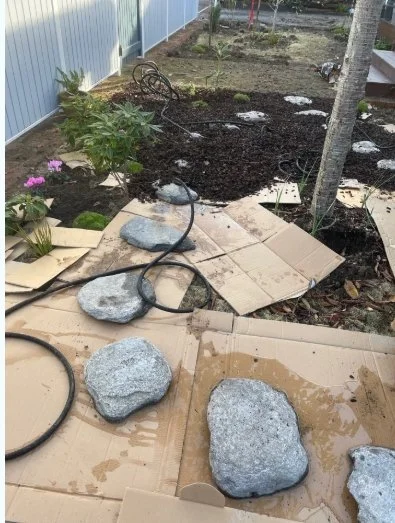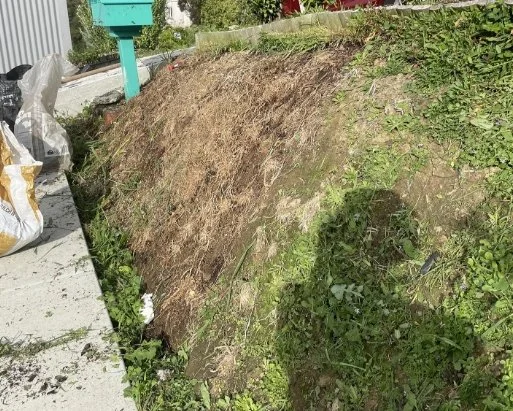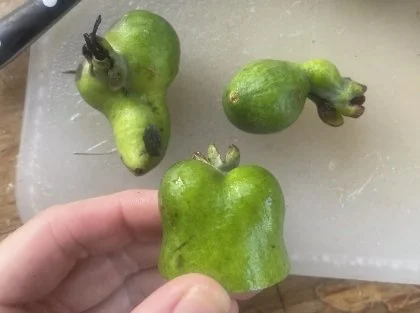Improving, not just maintaining
These past two weeks, I think I have lost the plot at a few of our gardens. Because most of the weeds are calming down, I’m looking back on the hectic Summer growth and refusing to accept a half-done garden. I am tired of weeding the same areas over and over and I bet my clients are too!
What this means in practice is that we have to lock down areas where we spend too much time. Time is precious, and at most of our properties we only get 2-3 hours a month to mow, edge, clear leaves and then jam in all of the weeding, pruning and trimming required for the season.
We have been ordering huge piles of mulch, and making good use of our chipper, so when we attend gardens we try to mulch any areas which are weeded, or areas that can stand to be mulched. And we’ve been trying out the ol’ cardboard trick-
Plants by Leacroft. Mulch by the Goods Shed. Cardboard by J A Russell Petone.
Step 1- remove large taprooted weeds.
Step 2- cover the area with cardboard, making sure that there are no gaps. Slide pieces of cardboard between any gaps where light may come through.
Step 3- Absolutely soak it until it is a sodden mess.
Step 4- Mulch on top.
This area took a skip bin’s worth of cardboard, so it isn’t for the faint hearted!
But lately I have thought, well, if it stops the weeds for 2 years- that’s two full years of no weeding. If I put down the thin, free, wool sheets that come with frozen food- and they stop weeds for 3 months, that’s 3 months of no weeding. If it is a pain in the bum relatively quickly (like coconut coir weedmatting, which weeds still grow through and get tangled in)… then even a short amount of weed-free-ness is not worth it.
Solarising
On a similar note, we ‘solarised’ this area by putting down black plastic for 6 months. It almost didn’t matter if it didn’t work, at this property the grass grows quickly year round, and it was taking over an hour to mow the lawns because of all of the steep grassy banks, so covering them in black plastic meant we could focus on other things. I wanted to leave it a full year, but the storms ripped it up and I was pleased to see that everything under the plastic is completely dead (there are some green bits- we weedeated the grass above before taking the photo, it is not living grass).
I’m quite pleased! There are a few nurseries that are real bargains, and they sell tiny plants for very cheap. I got the first load from NZ Native Plant Centre ($2.20 per plant), and the rest from my favourite, Piwakawaka Plants (who sell only on Facebook, and were kind enough to facilitate a drop off to me, $4 each). Cheap is king here, slopes are deceptively large areas- once this whole bank is planted there will be about 200 grasses on it!
What I am obsessed with this week
These misshapen feijoas!
She thicc. My family says I’m not allowed to say that.
They were all on the same tree- the last one in a row of three. Misshapen fruit is the result, usually, of a virus (fruit specific), bug damage at a very early age, or pollination issues.
We think of pollination being a tick box- it is achieved, or not achieved- but that isn’t the case at all. Flowers need *enough* pollen to create non-misshapen fruit, specifically in fruit which has multiple ovules/ovaries. Fruit which has multiple ovules is called ‘aggregate fruit’ and a key example is strawberries, or raspberries (or any berry which is made up of lots of tiny chambers). It sounds like feijoas aren’t an aggregate fruit, though.
What I do know is that this feijoa tree was totally crowded out by a flower bed that was dripping with bees all season, and it is quite a small tree- it is either the largest Feijoa Bambino I have seen, or the smallest of another variety… were these feijoas the product of lazy bees?
Feijoas aren’t really the focus of bugs to provide damage to the sensitive growth when a fruit or flower first forms, and this plant has no guava moth- so I don’t think it is bug or viral damage either, there’s no sign of that!
I am at the very edge of my knowledge and need to find a botanist. What I do know, though, is that Bambina feijoas are always a bit funky, what you get in terms of benefit in a much smaller plant you pay for in tiny, weird shaped fruit (and I do think these are Bambina trees, the skin of the feijoa is a bit of a giveaway).
Tasks for this week
Pick up your leaves and turn your compost piles, there is so much in terms of dead/dying growth to remove!
Have a fantastic week everyone!


